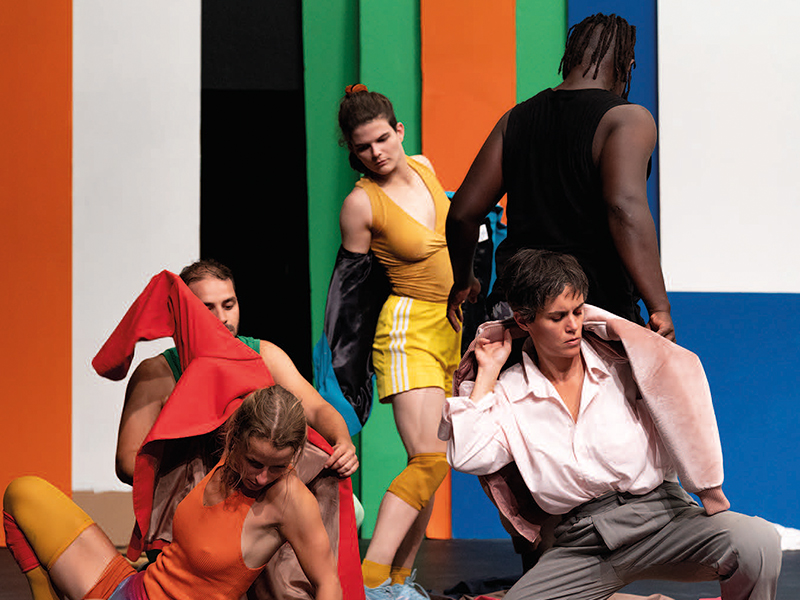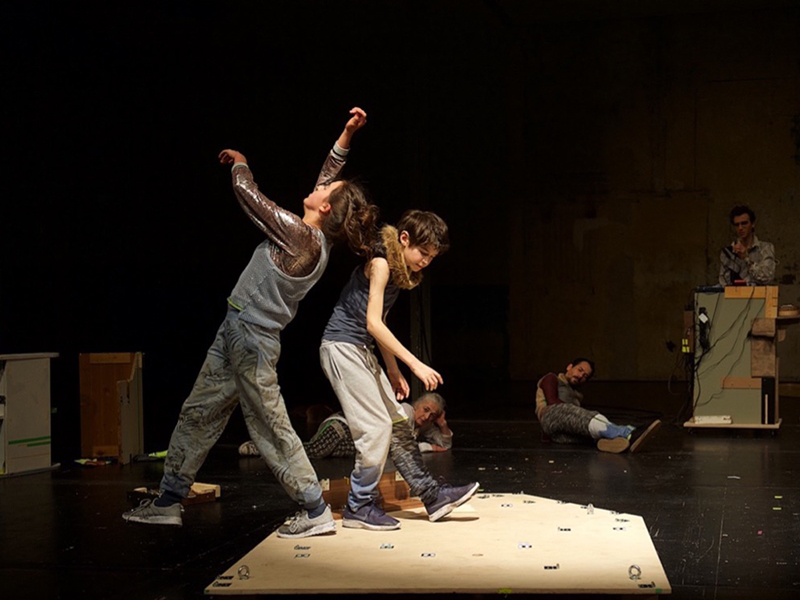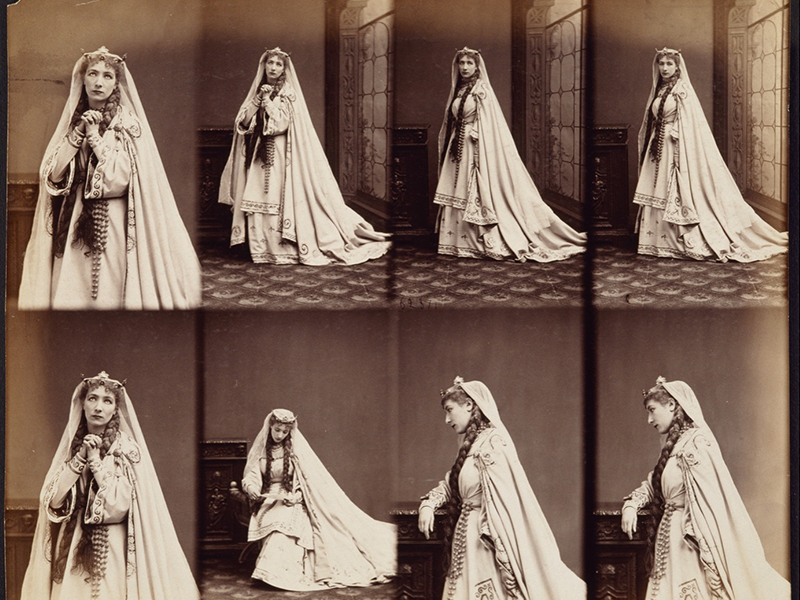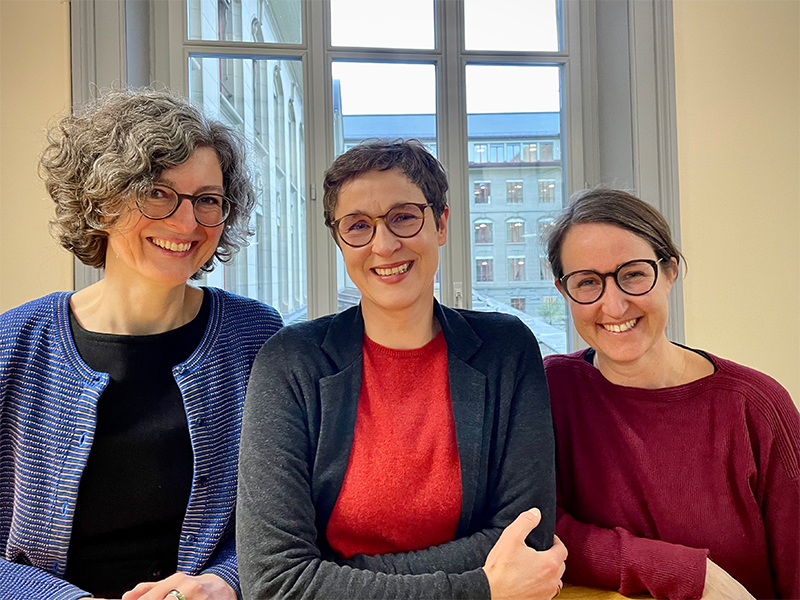Theater Studies
New on the big stage: Handbook of Theater and Dance
A book with almost 1,000 pages is touted as the “new standard work in theater and dance studies”: Three researchers from the Bern Institute of Theater Studies present an important handbook on the performing arts.

“You are keeping the entire field of theater and dance studies from Germany, Austria and Switzerland busy. It seems that anyone conducting research on the performing arts in the German-speaking world is only writing for this handbook!” This is the (tongue-in-cheek) complaint we got to hear whenever we met people from the field over the past two years.
When we say we, we mean theater historian Beate Hochholdinger-Reiterer, dance scholar Christina Thurner and theater and dance scholar Julia Wehren. All three of us carry out research and teach at the Institute of Theater Studies (ITW) at the University of Bern, the only institute for theater and dance studies at a Swiss university and the smallest in the German-speaking world.
About the handbook
Hochholdinger-Reiterer, Beate; Thurner, Christina; Wehren, Julia (ed.): Theater and dance. Handbook for science and studies. Baden-Baden: Nomos, Rombach Wissenschaft 2023.
In May 2021, we accepted a request from publisher Nomos/Rombach to conceptualize and implement a handbook for science and studies in the field of theater and dance. Two of us first had to be persuaded to do so, as this kind of project requires an immense amount of work. But it was worth it. We editors and everyone we had told about it and who we were able to persuade to participate felt that such a compendium was needed.

In 1949, the first and last handbook of German-language theater studies was published, and in 1997 a monograph focused on Austrian practice entitled Handbook of Theater and Dance. Since then, various encyclopedias were produced from one field or another, but never has there been such a comprehensive a handbook that combines as many perspectives as our collective work, which, moreover, combines theater and dance in its focus.
Theater reflects the world
Who should the book be aimed at and what interests should it serve? Why does anyone choose theater or dance studies as a field of study, as a field of work or want to know something about the performing arts out of pure curiosity? Perhaps because theater and dance allow us to reflect on so many things that affect us all: Our life (together), our world (environment), all possible or impossible spaces of effect and experience, our age and other ages, feelings, moods, discourses, criticisms, dreams and so on. All this means and is theater in all its forms; all this is discussed in the performing arts and investigated in theater and dance studies.
“Theater and dance allow us to reflect on so many things that affect us all”
During the planning and implementation of this handbook, we became truly aware of just how wide-ranging and compatible theater and dance studies are. Not only the history/stories of the subject, but also the spectrum of definitions and basic concepts, methods and theories as well as fields of work is broad, rich and diverse. As you can see from the results, the information can easily fill an entire volume. In fact several volumes could be filled immediately.
We selected, apportioned and divided up ideas from the multitude of ideas we had until we came up with the Handbook of Theater and Dance – a work containing four chapters and numerous sub-chapters. There are articles on the tragic and the comical as well as on dance anthropology, psychoanalysis and digital humanities in the context of theater studies; other articles deal with inclusive theater, circus forms, children and youth theater, performance, festivals and much more. In close contact and exchange with the 77 contributors, 97 articles were written, all reflecting the current state of research, expressing historical and current positions and discourses, identifying research gaps, and presenting new and sometimes surprising perspectives in the merging of theater and dance. For example, it became clear to us how different the progression of the two specialist histories is, but also how the disciplines can benefit from each other methodically.

It was not only important to us to bring together as many topics, subjects, perspectives, methods and approaches as possible, but also to involve as many specialists in German-speaking theater and dance studies as possible and to let them have their say. Some of those we asked had to decline our invitation for various and understandable reasons, but many, most gratifyingly, accepted and took part. In their articles, the writers took the trouble to get to the bottom of an ‘object’ of theater and/or dance studies, to locate it and to present it in such a way that experienced experts as well as curious students or interested laypeople can gain a well-founded and comprehensible insight. We were able to honor all the intended items and not a single item had to be eliminated, despite some withdrawals and redistributions.
Working with challenging obstacles
Working on the handbook meant an enormous amount of effort, not only for us, the editors, but also for every author, proofreader and all the other people who contributed to this book, which also came at a difficult and crisis-ridden time. Many had to contend with the coronavirus, its after-effects and repercussions on their family and professional lives, and had to cope with a more difficult semester due to the pandemic. You can't imagine the number of (unquestionably justified) reasons for the late submission of texts! The reasons why people were unable to write ranged from the lost handwritten article manuscript and elaborate intercontinental moves to daycare centers that were permanently closed. And yet it’s finished: The articles, the pictures, the bibliography, the indexes – the handbook is here and we are satisfied!
Many others contributed without writing for the book – at the publishing house and at our institute. Our assistants Tabitha Eberli-Zurbrügg, Sari Pamer, Salome Rickenbacher and Julia Wechsler played an active role. With their eagle eyes, they helped check stylesheets, literature, proofs and preparing the registers, and gained their first experiences with a major publication project.

Selecting the picture for the book cover unexpectedly proved to be difficult. We editors had mastered almost 1,000 pages of text, always complemented each other in writing and editing, and then for a short time it seemed as if we could not reach an agreement on this one final decision. One found the first picture suitable, another too bold, another too boring, another too specific or too gloomy, and so on. In the end, we were willing to compromise, but we searched for one last time – and found the picture, our picture. It is a photograph by Nicolas Montandon and shows a scene from the play DIEstinguished by the La Ribot Ensemble. The choreographer, director and performance artist La Ribot lives in Geneva and works all over the world from her base in Switzerland. With her works, she combines the performing arts by joyfully transcending their boundaries. This, we found, fits perfectly with our book and our understanding of our science.
About the Institute of Theater Studies
The Institute of Theater Studies (ITW) was founded in 1992 at the University of Bern and is still the first and only institute of theater and dance studies at a Swiss university. The aim is to explore local and international/national theater and dance phenomena in their aesthetic, cultural, temporal and social constitution. As part of the organizational structure of the Faculty of Humanities, the ITW offers theater and dance studies at bachelor’s and master’s level (study programs) as well as at doctoral level. The special areas of research and teaching are theater and dance history, contemporary theater and dance, theater and dance theory as well as theater and dance aesthetics. The ITW maintains a national and international network of diverse collaborations in the artistic and academic fields. An important component of the ITW is the close exchange between student representatives and the institute, resulting in numerous projects with and by students (e.g. workshops, theater visits, mentoring programs).
Subscribe to the uniAKTUELL newsletter

Discover stories about the research at the University of Bern and the people behind it.